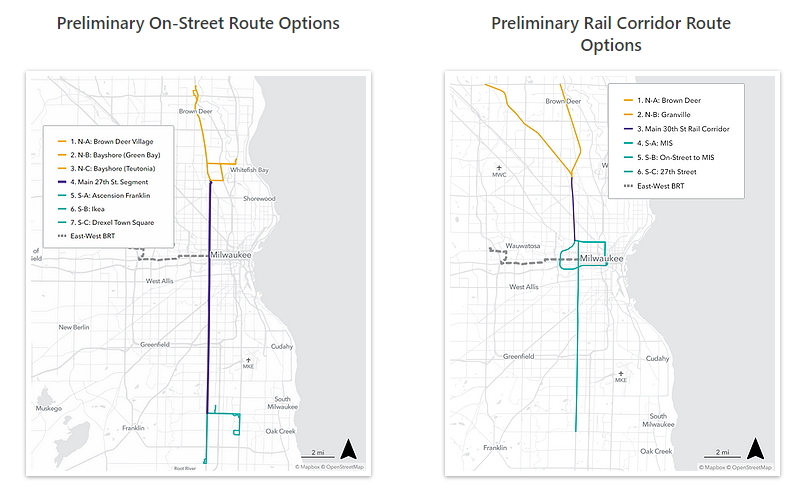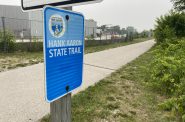27th Street Study Seeks Public Input
Regional planning commission expands public comment period to April 18th.

Preliminary on-street route options and preliminary rail corridor route options. Maps from the project website.
Milwaukee County and the Southeastern Wisconsin Regional Planning Commission (SEWRPC) are studying a new mass transit project for the 27th Street corridor, and they want more public input.
The project, called the “North-South Transit Enhancement Study” is looking at ways to enhance transit along one of the most heavily traveled corridors in the county. Currently the strip is served by the Milwaukee County Transit System’s (MCTS) Purple Line bus route.
For this reason, SEWRPC recently extended the public comment period for the first round of public meetings to April 18. The first of three rounds of public meetings were held virtually in February.
Plans and presentations can be viewed and public comments submitted on this website.
As Urban Milwaukee reported, the two preliminary route options include developing a new transit option along 27th Street from W. Hampton Avenue to W. Drexel Avenue. The other route option would see the main drag run along the 30th Street Rail Corridor from W. Hampton Avenue to W. Lisbon Avenue.
In both options, the transit service would ultimately run the entire length of the county north to south.
There is a mix of transit options on the table including commuter rail, light rail, bus, streetcar and Bus Rapid Transit (BRT).
BRT is a high-frequency service that uses a number of technologies, like off-bus ticketing, and infrastructure upgrades, such as dedicated lanes, to improve the frequency and speed of service along the route.
In County Executive David Crowley’s 2021 budget, he noted that the county was studying transit enhancements in the corridor and said “Racial equity will be given deliberate consideration in the study, as this corridor is accessible to environmental justice populations and a high density of jobs.”
Within a half mile of the 27th Street corridor 63% of residents live in poverty, one in five families are without a car and 76% of residents are people of color, according to a report by MCTS.
Along the corridor, MCTS stated, there are 49,223 jobs, four major medical facilities (including Aurora St. Luke’s Medical Center), 63 K-12 schools, 31 grocery stores, five big box stores and 12 community resource centers (which include job centers).
If you think stories like this are important, become a member of Urban Milwaukee and help support real, independent journalism. Plus you get some cool added benefits.
More about the North-South Transit Study
- Transportation: MCTS Halting Plans for Second Bus Rapid Transit Route - Graham Kilmer - Aug 16th, 2024
- Transportation: Make Your Opinion Known On Second BRT Line - Graham Kilmer - Mar 8th, 2024
- Transportation: MCTS Seeking Board Approval For 27th Street BRT Line - Graham Kilmer - Feb 23rd, 2024
- Transportation: 27th Street Rapid Bus Route Would Launch In 2028 - Graham Kilmer - Dec 6th, 2023
- MKE County: Proposed North-South BRT Line Loses Southern Anchor - Graham Kilmer - Feb 9th, 2023
- Transportation: North-South BRT Plans Advancing in 2023 - Graham Kilmer - Jan 25th, 2023
- Transportation: Proposed Route for North-South BRT Line Unveiled - Jeramey Jannene - Sep 16th, 2022
- Transportation: County Must Decide On North-South BRT - Graham Kilmer - Jul 19th, 2022
- Transportation: Milwaukee Studying Second BRT Line - Jeramey Jannene and Graham Kilmer - Oct 25th, 2021
- Transportation: 27th Street Study Seeks Public Input - Graham Kilmer - Apr 2nd, 2021
Read more about North-South Transit Study here
Political Contributions Tracker
Displaying political contributions between people mentioned in this story. Learn more.
MKE County
-
RNC Will Cause Some County Services To Be Moved to Wauwatosa
 Jul 12th, 2024 by Graham Kilmer
Jul 12th, 2024 by Graham Kilmer
-
Hank Aaron State Trail Will Be Closed For RNC, State Fair
 Jul 12th, 2024 by Graham Kilmer
Jul 12th, 2024 by Graham Kilmer
-
MCTS Designing New Bus Shelters
 Jul 10th, 2024 by Graham Kilmer
Jul 10th, 2024 by Graham Kilmer
Transportation
-
MCTS Adds 28 New Buses
 Jul 13th, 2024 by Graham Kilmer
Jul 13th, 2024 by Graham Kilmer
-
MCTS Designing New Bus Shelters
 Jul 10th, 2024 by Graham Kilmer
Jul 10th, 2024 by Graham Kilmer
-
MCTS Updates RNC Bus Detours To Better Serve Downtown, Riders
 Jul 9th, 2024 by Jeramey Jannene
Jul 9th, 2024 by Jeramey Jannene






















Erasing local neighborhoods through highway construction severed communities here in the previous century (Niemuth, 2014). We must now rebalance these inequities and address equity, safety, and environmental concerns.
The 27th Street corridor has been called the “Deadliest road in Milwaukee” (Klopf, 2021). This danger is often ignored and arises due to bias in engineering and infrastructure that doesn’t acknowledge the needs of residents, pedestrians, the disabled, or the elderly (Schmitt, 2020). A focus should be on the needs of car-free households, low-income households, and people who might like to use transit instead of driving.
This project considers Bus Rapid Transit (BRT), Light Rail Transit (LRT), and streetcar modes. Many metropolitan areas utilize these modes at different scales: LRT across a city, streetcars in neighborhoods, and buses or BRT in lower-density corridors. All can work together, and all are successful public transit modes (Speiler, 2018). What is in question is the design purpose of improving the 27th Street corridor. The design purpose should come directly from equity, safety, and environmental concerns. Equitable mobility and support for walkability should be a primary concern in the neighborhoods. For service across greater distances, the connections should join neighborhood centers with the entire area. The choice of emissions-free vehicles can address climate and health concerns. Rail service can use power efficiently and give “economic, social, and environmental benefits” (Litman, 2020). The local stops should reach people in neighborhoods with pedestrian-friendly surroundings. On a metropolitan scale, the service should connect major centers and reduce dependence on automobiles.
With higher-quality transit, there are concerns about gentrification and displacement (Diciaula, 2019). Anti-displacement-oriented planning should work toward equity by “community connectivity and neighborhood network planning” (Thomas, 2020). Isolating populations from high-quality transit by placing it in just one location causes inequities due to scarcity when communities without it are left behind or stranded (Spieler, 2020).
A modern streetcar service can support walkable urbanism in neighborhoods with user-accommodating, emissions-free, and energy-efficient travel. The streetcar’s permanent infrastructure serves as a catalyst and support for development, and the streetcar works as transit. The Hop streetcar has been proven locally on our streets and climate in Milwaukee (December, 2021). LRT can cover longer-distance connections so that passengers can move more rapidly across the area, but, at stations, smoothly change transit modes among LRT, streetcar, bus, or walking.
Examples throughout the world show how community equity and prosperity can come about with superior transit alternatives because transit itself is a shaper of cities (Newman and Kenworthy, 1999).
References
December, John. “Advantages of Streetcars,” March 12, 2021, Personal Blog, Retrieved March 27, 2021 from https://johndecember.com/places/mke/streetcar/advantages.html
Diciaula, Joshua. (2019). Transit-Oriented Development and the Implications for Equitable Development: A Case Study of the Milwaukee Streetcar. Theses and Dissertations, University of Wisconsin–Milwaukee. 2174. https://dc.uwm.edu/etd/2174
Klopf, Rebecca, “Deadliest road in Milwaukee claims a dozen lives in 2020,” February 23, 2021, WTMJ-TV Milwaukee Local News, Retrieved March 27, 2021 from https://www.tmj4.com/news/local-news/deadliest-road-in-milwaukee-claims-a-dozen-lives-in-2020
Litman, Todd. (2020, 29 April). Rail Transit In America: A Comprehensive Evaluation of Benefits. Victoria Transport Policy Institute. Retrieved February 28, 2021 from https://vtpi.org/railben.pdf
Newman, P., L. Kosonen, and J. Kenworthy. (2016). “Theory of urban fabrics: Planning the walking, transit/public transport and automobile/motor car cities for reduced car dependency.” Town Planning Review 87 (4): 429-458. Retrieved March 25, 2021 from http://hdl.handle.net/20.500.11937/11247
Niemuth, Niles William. (2014). Urban Renewal and the Development of Milwaukee’s African American Community: 1960-1980. Theses and Dissertations, University of Wisconsin–Milwaukee. 416. Retrieved March 18, 2021 from https://dc.uwm.edu/etd/416
Schmitt, Angie. (2020) Right of Way: Race, Class, and the Silent Epidemic of Pedestrian Deaths in America. Island Press.
Spieler, Christof, “Racism has shaped public transit, and it’s riddled with inequities,” August 24, 2020, Urban Edge, The Kinder Institute for Urban Research, Retrieved March 25, 2021 from https://kinder.rice.edu/urbanedge/2020/08/24/transportation-racism-has-shaped-public-transit-america-inequalities
Spieler, Christof. (2018). Trains, Buses, People: An Opinionated Atlas of US Transit. Island Press.
Thomas, Destiny. “Opinion: Urbanism is Complicit in Infra-Structural Racism–And Reparations Have a Place in the Built Environment,” July 27, 2020, Streetsblog USA. Retrieved March 6, 2021 from https://usa.streetsblog.org/2020/07/27/opinion-urbanism-is-complicit-in-infra-structural-racism-and-reparations-have-a-place-in-the-built-environment/